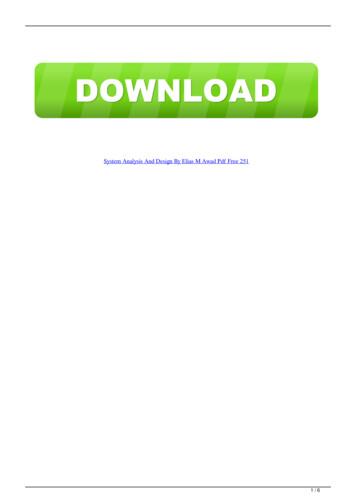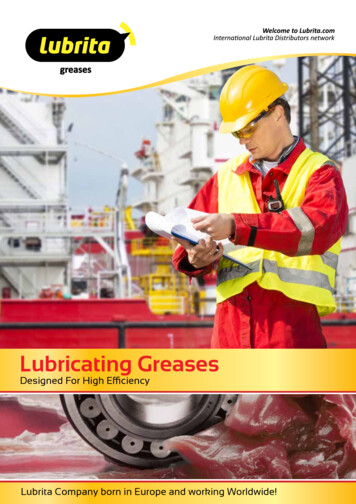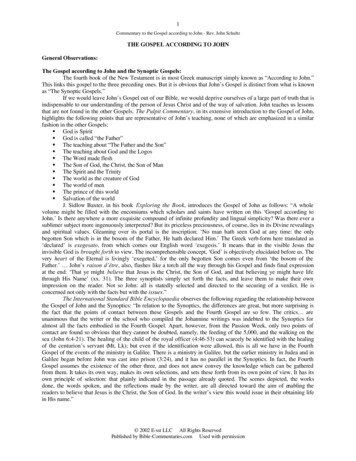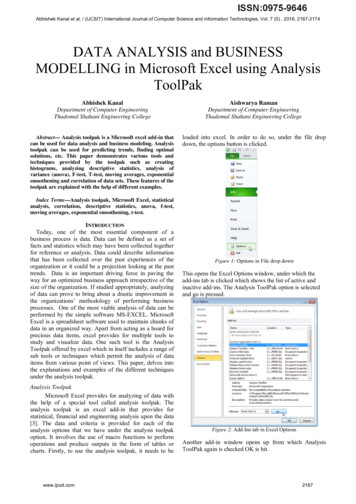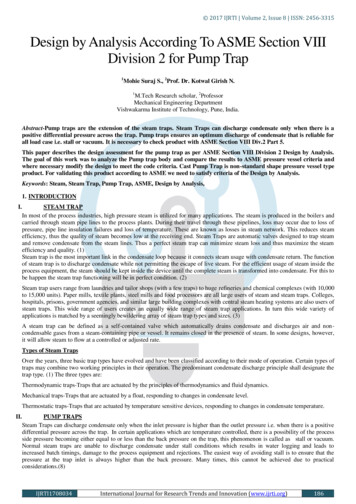
Transcription
2017 IJRTI Volume 2, Issue 8 ISSN: 2456-3315Design by Analysis According To ASME Section VIIIDivision 2 for Pump Trap1Mohie Suraj S., 2Prof. Dr. Kotwal Girish N.1M.Tech Research scholar, 2ProfessorMechanical Engineering DepartmentVishwakarma Institute of Technology, Pune, India.Abstract-Pump traps are the extension of the steam traps. Steam Traps can discharge condensate only when there is apositive differential pressure across the trap. Pump traps ensures an optimum discharge of condensate that is reliable forall load case i.e. stall or vacuum. It is necessary to check product with ASME Section VIII Div.2 Part 5.This paper describes the design assessment for the pump trap as per ASME Section VIII Division 2 Design by Analysis.The goal of this work was to analyze the Pump trap body and compare the results to ASME pressure vessel criteria andwhere necessary modify the design to meet the code criteria. Cast Pump Trap is non-standard shape pressure vessel typeproduct. For validating this product according to ASME we need to satisfy criteria of the Design by Analysis.Keywords: Steam, Steam Trap, Pump Trap, ASME, Design by Analysis,1. INTRODUCTIONI.STEAM TRAPIn most of the process industries, high pressure steam is utilized for many applications. The steam is produced in the boilers andcarried through steam pipe lines to the process plants. During their travel through these pipelines, loss may occur due to loss ofpressure, pipe line insulation failures and loss of temperature. These are known as losses in steam network. This reduces steamefficiency, thus the quality of steam becomes low at the receiving end. Steam Traps are automatic valves designed to trap steamand remove condensate from the steam lines. Thus a perfect steam trap can minimize steam loss and thus maximize the steamefficiency and quality. (1)Steam trap is the most important link in the condensate loop because it connects steam usage with condensate return. The functionof steam trap is to discharge condensate while not permitting the escape of live steam. For the efficient usage of steam inside theprocess equipment, the steam should be kept inside the device until the complete steam is transformed into condensate. For this tobe happen the steam trap functioning will be in perfect condition. (2)Steam trap users range from laundries and tailor shops (with a few traps) to huge refineries and chemical complexes (with 10,000to 15,000 units). Paper mills, textile plants, steel mills and food processors are all large users of steam and steam traps. Colleges,hospitals, prisons, government agencies, and similar large building complexes with central steam heating systems are also users ofsteam traps. This wide range of users creates an equally wide range of steam trap applications. In turn this wide variety ofapplications is matched by a seemingly bewildering array of steam trap types and sizes. (3)A steam trap can be defined as a self-contained valve which automatically drains condensate and discharges air and noncondensable gases from a steam-containing pipe or vessel. It remains closed in the presence of steam. In some designs, however,it will allow steam to flow at a controlled or adjusted rate.Types of Steam TrapsOver the years, three basic trap types have evolved and have been classified according to their mode of operation. Certain types oftraps may combine two working principles in their operation. The predominant condensate discharge principle shall designate thetrap type. (1) The three types are:Thermodynamic traps-Traps that are actuated by the principles of thermodynamics and fluid dynamics.Mechanical traps-Traps that are actuated by a float, responding to changes in condensate level.Thermostatic traps-Traps that are actuated by temperature sensitive devices, responding to changes in condensate temperature.II.PUMP TRAPSSteam Traps can discharge condensate only when the inlet pressure is higher than the outlet pressure i.e. when there is a positivedifferential pressure across the trap. In certain applications which are temperature controlled, there is a possibility of the processside pressure becoming either equal to or less than the back pressure on the trap, this phenomenon is called as stall or vacuum.Normal steam traps are unable to discharge condensate under stall conditions which results in water logging and leads toincreased batch timings, damage to the process equipment and rejections. The easiest way of avoiding stall is to ensure that thepressure at the trap inlet is always higher than the back pressure. Many times, this cannot be achieved due to al Journal for Research Trends and Innovation (www.ijrti.org)186
2017 IJRTI Volume 2, Issue 8 ISSN: 2456-3315Using a new generation of extremely compact pump traps ensures an optimum discharge of condensate that is reliable for all loadcases. These devices unite a drain function with a demand-dependent pump function. In comparison to normal float traps, theyhave two additional connections for the motive steam and for a vent line as well as integrated solenoid valves and non-returnelements. In addition to a time proven rolling ball regulator, there is a mechanism which automatically injects high pressure steaminto the body when the pressure is too low. This motive steam, the condensate is actively transported into the condensate system.If the pressure in the heat exchanger is sufficiently high, the rolling ball regulator acts as a conventional float trap withoutemploying any additional motive steam.2. ANALYSIS REQUIREMENTSThe ASME Division 2 rules call out the required procedures and define the allowable yield strength, ultimate strength, strainlimit, buckling load, and collapse load that must be satisfied. These procedures are based on protection against failure modes.They are; protection against Plastic Collapse, protection against Local Failure, protection against Collapse from Buckling andprotection against Failure From Cyclic Loading. The procedures called out may only be used if the allowable stress evaluated atthe design temperature is governed by time independent properties unless the specific design procedure allows it. The Pump trapwas analyzed following these step by step requirements, the analysis and results of the analysis procedures is presented here. Atthe time of this analysis set the pressure limits in the trap is 14 bar. This pressure is the maximum allowable working pressure,MAWP, for all analyses. Vacuum pressure for buckling criteria is 1 bar vacuum pressure. The load case combination are given infigures, 5.3 of the 2010 Section VIII, Division 2 code. Design by Analysis, in which designer performs stress analysis andevaluates results against code limits, was intended for configurations not covered by the Design By Formula.(5)I.DESIGN BY ANALYSISDesign-by-analysis method assumes a numerical analysis technique will be used, and either elastic or elastic-plastic analysis ispermitted. In the case of the trap, ANSYS structural analysis software was used to perform the finite element analyses andprovide protection against four modes of failure: plastic collapse, buckling, cyclic loading and local fracture. (5)Materials of ConstructionMaterial of Cast PUMP TRAP cover and base body is Ductile steel (60-40-18). Material properties of steel are taken from ASMESection VIII Div.1 Table No. UCD 23. All the material properties described in below Table 1Material PropertiesUltimate tensile strength Sut 414 Stress oroom temp2.00E 0582.727671000.32042.00E 0582.727671000.33162.00E 0582.727671000.3( Table 1:- Material properties of ductile cast steelFEA Analysis of Cast PUMP TRAP is calculated for the following load case as per design data1.2.LC1 – Internal Design Pressure (Load Controlled)LC2 – Hydro Test PressureWind Load, Snow Load, Earthquake Load and live load is not applicable for this product so only following Load casecombinations are applicable.1)LC1 – INTERNAL DESIGN PRESSURE (LOAD CONTROLLED)A.PROTECTION FROM PLASTIC COLLAPSEThree alternative analysis methods are acceptable for evaluating the structure for protection against plastic collapse. The first isthe elastic stress analysis method, the second is the Limit-Load Method and the third is the Elastic-Plastic Stress AnalysisMethod.i.ELASTIC STRESS ANALYSIS METHODTo evaluate protection against plastic collapse, the results from an elastic stress analysis of the component subject to definedloading conditions are categorized and compared to an associated limiting value.IJRTI1708034International Journal for Research Trends and Innovation (www.ijrti.org)187
2017 IJRTI Volume 2, Issue 8 ISSN: 2456-3315Load controlled Load case combination only consider the pressure and mechanical load not thermal effect. So that StructuralAnalysis is perform for all above load case combination. For the above load case wind load, earthquake load, and live load arezero. Structural analysis is perform for all the above load case combination in load controlled load case.Geometry and FE ModelingFor the analysis according to the load case Cast PUMP TRAP is modeled in Solid Edge-ST7. Solid 187 element is used. Forcontact between parts CONTA 174 and TARGE 170 element is used. Meshing size is 10 mm is used. Total No. of nodes are316110. 14 bar pressure (P) is applied inside the body and hydrostatic pressure (Ps) is applied up to the snapping point locationwhich is 2/3 area from bottom. Displacement boundary condition is applied on the flanges of inlet and outlet pipe.Figure 1:- Mesh Model of Cast Pump TrapFigure 2:- Loading and boundary condition of Cast Pump TrapResults for all loading conditionResults obtained after analysis are the maximum deformation 0.22939 mm. at the center of the cover body and maximum VonMises stress is 181.018 MPa. Stress linearization is done at the various section of the model. Maximum Von-Mises stress locationis localized so at that location local primary membrane stress is considered. The critical linearized stress shown in belowLoad CasePm (MPa)PL (MPa)PL PB(MPa)Von MisesStress(MPa)Deformation(mm)StrainP PS D29.44232.66287.912181.020.2290.000910.9P PS onal Journal for Research Trends and Innovation (www.ijrti.org)188
2017 IJRTI Volume 2, Issue 8 ISSN: 2456-3315local primary membrane primary bending principal stressσ1 (MPa)σ2 (MPa)σ3 260286.33E-02Table 2:-FEA Result of load case LC1 analysis of Cast modelChecking for use of the Elastic Stress analysis method Heavy wall thickness condition for pressure containing component.Heavy wall condition,R min 4tR min 73 mm, t 15 mm73 4.8666 415So it is thin wall pressure containing component. So that we can use Elastic Stress Analysis method.Allowable Stress, S 82.7 MPa.SPL Will be larger of 1.5 times allowable stress or yield strength depend on following condition,Syt276 0.667 0.7Sut414So use another condition that is,SPL Syt 276 MPa.Result from Ansys (stresses) obeRemarkconditionPm29.442S82.7Pm SsatisfiedPL32.662Spl276PL SplsatisfiedPL PB87.912Spl276PL PB SplsatisfiedaboutTable 3:-Protection against plastic collapse criteria for load case 1 for cast pump trapSo it is satisfying condition of the protection against plastic collapse. So it is safe in protection against plastic collapse.B.PROTECTION AGAINST LOCAL FAILUREIn addition to demonstrating protection against plastic collapse, the following elastic analysis criterion shall be satisfied for eachpoint in the component.σ1 σ2 σ3 102.45 33.344 18.087 153.881 MPa4 X S 4 X 82.7 . 330.8 MPaUtilization Factor IJRTI1708034Analysis ResultDesign LimitσVON4XSInternational Journal for Research Trends and Innovation (www.ijrti.org)189
2017 IJRTI Volume 2, Issue 8 ISSN: 2456-3315 181.08330.8 0.5474Result from(Stress in MPa)AnsysAllowableValues (MPa)StressCondition to be satisfiedσ1 σ2 σ34Sσ1 σ2 σ3 4 S153.881330.8153.881 330.8RemarkconditionaboutsatisfiedTable 4:- Protection against local failure criteria for load case 1 cast pump trapSo it is satisfying condition of the protection against Local Failure and also Utilization Factor is Less than one. So it is safe inprotection against Local Failure.2)HYDRO TEST PRESSURELoad Case: - LC 2 (Hydro-Test Pressure)Load Case combination1.P Ps D2.0.9P Ps D (0.6W or 0.7 E)In the testing load case only above Load case combination are consider, according to the ASME Section VIII Div. 2 Table 5.1. Sothat Structural Analysis is perform for all above load case combination. For the above load case wind load, earthquake load, andlive load are zero.Hydrostatic test pressure 1.5 times design pressure 1.5 X 16 24 BarStructural analysis according to Hydro-Test Pressure ConditionGeometry and FE Modeling:Geometry and FE modeling is as same as the Load case 1 (LC-1). But in the loading condition areP 24 bar.Ps hydrostatic (Water) pressure,D dead (self) weight of cast model,Displacement boundary condition are same as LC1. After the analysis performed results are shown below. Maximum Von-Misesstress image shown below in FigureFigure 3: - Hydro test condition deformation of Cast modelHydro Test Pressure Condition load case resultIJRTI1708034International Journal for Research Trends and Innovation (www.ijrti.org)190
2017 IJRTI Volume 2, Issue 8 ISSN: 2456-3315For both load case structural stress analysis is performed. Then stress linearization at various section of the model is done. Fromavailable stress linearization maximum linearized value consider for each case which are shown in below Table 5Load CasePm (MPa)PL (MPa)PL PB(MPa)Stress(MPa)Deformation(mm)StrainP PS D37.79940.23133.97240.10.47860.0012010.9P PS D34.01836.209120.57216.10.43080.001081local primary membrane primary bending principal stressσ1 (MPa)σ2 (MPa)σ3 (MPa)134.34127.14-3.0827120.9114.43-2.774Table 5:-FEA Result of hydro testing load case analysis of Cast modelFrom the result of above load case P Ps D Load case combination is critical, so it is consider for the Protection against plasticcollapse and protection against local failure. Maximum stress location is in the inside cover body near inlet pipe. Location is sameas the load case LC1.Figure 4:-Equivalent Von-Mises stress for Hydro test load caseAnsys Results Interpreted with ASME section VIII Division 2 Part 5A.PROTECTION AGAINST PLASTIC COLLAPSE:-Condition is checked in Load controlled load case and component is also not changed so from the result calculated for thin wallcondition in above load case is considered. So it is thin wall pressure containing component. So that we can use Elastic StressAnalysis method.Allowable Stress, S 82.7 MPaSPL Syt 276 MPaFrom the result table 6 and as discussed in the literature of the ASME Sec VIII Div. 2 check all the result as per condition of theElastic Stress Analysis MethodResult from Ansys (stresses inMPa)IJRTI1708034Allowable Stress ternational Journal for Research Trends and Innovation (www.ijrti.org)about191
2017 IJRTI Volume 2, Issue 8 ISSN: 2456-3315Pm37.799S82.7Pm SsatisfiedPL40.23SPL276PL SPLsatisfiedPL PB133.97SPL276PL PB SPLsatisfiedTable 6:-Protection against plastic collapse criteria for load case 3 for cast pump trapSo it is satisfying condition of the protection against plastic collapse. So it is safe in protection against plastic collapse.B.PROTECTION AGAINST LOCAL FAILUREIn addition to demonstrating protection against plastic collapse, the following elastic analysis criterion shall be satisfied for eachpoint in the component.σ1 σ2 σ3 134.4 127.14 (-3.0827) 258.3973 MPa4 X S 4 X 82.7 330.8 MPa.𝐴𝑛𝑎𝑙𝑦𝑠𝑖𝑠 𝑅𝑒𝑠𝑢𝑙𝑡𝐷𝑒𝑠𝑖𝑔𝑛 ��𝑖𝑜𝑛 𝐹𝑎𝑐𝑡𝑜𝑟 σVON4XS 240.1330.8 0.725816Result from Ansys(Stresses in MPa)Allowable ValuesCondition to be satisfiedσ1 σ2 σ34Sσ1 σ2 σ3 4 S258.397330.8258.3973 330.8RemarkconditionaboutsatisfiedTable 7:-Protection against local failure criteria for load case 3 for cast pump trapSo it is satisfying condition of the protection against Local Failure and also Utilization Factor is Less than one. So it is safe inprotection against Local Failure.C.PROTECTION AGAINST COLLAPSE FROM BUCKLINGThe design factor to be used in a structural stability assessment is based on the type of buckling analysis performed. Bifurcationbuckling analysis is performed using an elastic stress analysis without geometric nonlinearities in the solution to determine thepre-stress in the component. Cast pump trap is working under vacuum condition so that it produces compressive stress field. Socast pump trap also needed to be satisfy protection against collapse from buckling criteria.Capacity Reduction Factor (βCR ) for spherical shell and spherical tori-spherical elliptical heads under external pressure,βCR 0.124Minimum design factor B β2CR2 0.124 16.129This is the minimum design factor for buckling analysis.Buckling analysis according to buckling load conditionIJRTI1708034International Journal for Research Trends and Innovation (www.ijrti.org)192
2017 IJRTI Volume 2, Issue 8 ISSN: 2456-3315Vacuum load P -1 bar.For the buckling analysis firstly structural analysis is perform with 1 bar vacuum pressure, hydrostatic water pressure, self-weightand displacement boundary condition is applied inlet and outlet flange. Structural analysis result is import in buckling simulation.Pre-stress load pattern is static structural. Buckling analysis shows the load multiplier which is similar to the safety factor for thatparticular load case. Load multiplier must be greater than min. design factor as per ASME Section VIII Div. 2 for satisfyingbuckling criteria.Results of buckling analysisFigure 5:-Buckling mode shapeFrom FEA result it is found that first buckling mode has a load factor of 180.91and is significantly above the load factor ofminimum design factor of 16.129. So it is safe in Protection against collapse from buckling.3. EXPERIMENTATIONI.STRAIN MEASUREMENTExperimental stress analysis is perform using strain gauges with Wheatstone bridge circuit. Then Experimental results arecompared with FEA. The product surface is not in one plane so that delta rosette configuration strain gauges are required for thestress measurement. We selected the region where maximum deformation is seen in FEA for stress measurement. For this threeWheatstone bridge circuit are used on the circuit panel. Wheatstone bridge circuit panel shown in Figure below,Figure 6:- three Wheatstone bridge circuit panelWheatstone bridge circuit used component specification,Resistor, R 330 ΩBattery 0 9 voltStrain gauge 350 ΩCapacitor 100𝜇𝐹IC 7805Digital Multi-MeterIJRTI1708034International Journal for Research Trends and Innovation (www.ijrti.org)193
2017 IJRTI Volume 2, Issue 8 ISSN: 2456-3315Strain gauge installation method1.Clean surfaceUse a solvent (such as acetone or alcohol) to remove any grease or oils from the surface to which the stain gage will be bonded.This is to prevent any contaminants from being driven into the surface while performing subsequent steps. Clean an areasignificantly larger than the gage (4 to 6 inches on all sides) to prevent any contaminants from the surrounding area from beingintroduced into the gage area.2.Abrade surfaceRemove any oxidation, paint or coating from the surface finishing the abrading with a 400 grit silicone-carbide paper to ensure aproper texture for adhesion.3.Mark layout linesUse a clean rule and a hard pencil or pen to mark the desired position of the gage.4.Transferring gageUse a proper length, about 15 cm (6 in), of cellophane tape to pick up the strain gage and transfer it to the gaging area of thespecimen. Align the gage with the layout lines. Press one end of the tape to the specimen, then smoothly and gently apply thewhole tape and gage into position.5.Applying adhesiveApply enough adhesive to provide sufficient coverage under the gage for proper adhesion.6.Removing tapeLeave the tape in place at least two more minutes after the thumb was removed. Peel the tape from the specimen slowly andsmoothly from one end to the other end.Figure 7:- strain gauges on the productAfter installing strain gauges on the product, Wheatstone bridge circuit lead wire connected to strain gauges. Then for testingwater pressure is applied inside the product and strain measured across Wheatstone bridge output using digital multi-meter.Reading taken on Digital Multi-meter across each strain gauge connected Wheatstone bridge circuit are in millivolt. Wheatstonebridge setup with product shown belowFigure 8:-product with strain measurement setupStrain gauges reading on multi meter shown in below Table 8,Pressure (Bar)IJRTI1708034Strain Gauge 1 (mV)Strain Gauge 2 (mV)Strain Gauge 3 (mV)International Journal for Research Trends and Innovation (www.ijrti.org)194
2017 IJRTI Volume 2, Issue 8 ISSN: 2456-3315Initial 110.5106Table 8:-strain gauges reading on digital multi-meterTo calculate experimental strain in the direction of strain gauge from strain gauge reading.Vr (Vstrained Vunstrained)V ex 4Vrεi GF 1 2VrPrincipal strain from strain of 3-strain gauges𝐄𝐢 𝛆𝟏 𝛆𝟐 𝛆𝟑𝟐 (𝛆𝟏 𝛆𝟐 )𝟐 (𝛆𝟐 𝛆𝟑 )𝟐 (𝛆𝟑 𝛆𝟏 )𝟐𝟑𝟑Principal stress from principal strain𝐒𝟏 𝐌𝐨𝐝𝐮𝐥𝐮𝐬 𝐨𝐟 𝐞𝐥𝐚𝐬𝐭𝐢𝐜𝐢𝐭𝐲 (𝐄𝟏 𝛍𝐄𝟐 )(𝟏 𝛍𝟐 )𝑺𝟏 𝐌𝐨𝐝𝐮𝐥𝐮𝐬 𝐨𝐟 𝐞𝐥𝐚𝐬𝐭𝐢𝐜𝐢𝐭𝐲 (𝛆𝟐 𝛍𝛆𝟐 )(𝟏 𝛍𝟐 )For 5 bar pressure reading calculation for strain gauge 1𝐕𝐫 (𝐕𝐬𝐭𝐫𝐚𝐢𝐧𝐞𝐝 𝐕𝐮𝐧𝐬𝐭𝐫𝐚𝐢𝐧𝐞𝐝)𝐕 𝐞𝐱𝐕𝐫 𝟗𝟓. 𝟖 𝟗𝟔𝟓𝟎𝟎𝟎𝐕𝐫 𝟒 𝐗 𝟏𝟎 𝟓𝛆𝟏 𝟒 𝐗 𝟒𝐗 𝟏𝟎 𝟓𝟐. 𝟐 (𝟏 𝟐 ( 𝟒𝐗 𝟏𝟎 𝟓 )𝛆𝟏 𝟕. 𝟐𝟕𝟑𝟑 𝐗 𝟏𝟎 𝟓Strain value for each pressure shown below,pressure JRTI1708034International Journal for Research Trends and Innovation (www.ijrti.org)195
2017 IJRTI Volume 2, Issue 8 ISSN: 00E-04Table 9:-calculated strain value for each strain gauge resultFrom strain value calculate principal strain (E), principal stress(S) and von-Mises stresses (Svm) as followPrincipal strain from strain of 3-strain gauges for 5 bar pressure𝛆𝟏 𝛆𝟐 𝛆𝟑𝟐 (𝛆𝟏 𝛆𝟐 )𝟐 (𝛆𝟐 𝛆𝟑 )𝟐 (𝛆𝟑 𝛆𝟏 )𝟐𝟑𝟑𝟕. 𝟐𝟕𝟑𝟑𝟏𝐄 𝟎𝟓 𝟑. 𝟔𝟑𝟔𝟓𝟏𝐄 𝟎𝟓 𝟕. 𝟐𝟕𝟑𝟑𝟏𝐄 𝟎𝟓 𝟑𝐄𝐢 𝐄𝟏,𝟐 𝟐(𝟕. 𝟐𝟕𝟑𝟑𝟏𝐄 𝟎𝟓 𝟑. 𝟔𝟑𝟔𝟓𝟏𝐄 𝟎𝟓)𝟐 (𝟑. 𝟔𝟑𝟔𝟓𝟏𝐄 𝟎𝟓 𝟕. 𝟐𝟕𝟑𝟑𝟏𝐄 𝟎𝟓)𝟐 (𝟕. 𝟐𝟕𝟑𝟑𝟏𝐄 𝟎𝟓 𝟕. 𝟐𝟕𝟑𝟑𝟏𝐄 𝟎𝟓)𝟐𝟑𝐄𝟏 𝟖. 𝟓 𝐗 𝟏𝟎 𝟓 , 𝐄𝟐 𝟑. 𝟔𝟒 𝐗 𝟏𝟎 𝟓Principal stress from principal strain𝐒𝟏 𝐌𝐨𝐝𝐮𝐥𝐮𝐬 𝐨𝐟 𝐞𝐥𝐚𝐬𝐭𝐢𝐜𝐢𝐭𝐲 (𝐄𝟏 𝛍𝐄𝟐 )(𝟏 𝛍𝟐 )𝐒𝟏 𝟐 𝐗 𝟏𝟎𝟓 (𝟖. 𝟓𝐗 𝟏𝟎 𝟓 𝟎. 𝟐𝟖 𝐗 𝟑. 𝟔𝟒𝐗 𝟏𝟎 𝟓 )(𝟏 𝟎. 𝟐𝟖𝟐 )S1 26.4 MPa.𝐒𝟐 𝐌𝐨𝐝𝐮𝐥𝐮𝐬 𝐨𝐟 𝐞𝐥𝐚𝐬𝐭𝐢𝐜𝐢𝐭𝐲 (𝛆𝟐 𝛍𝛆𝟐 )(𝟏 𝛍𝟐 )𝐒𝟐 𝟐 𝐗 𝟏𝟎𝟓 ( 𝟑. 𝟔𝟒 𝐗 𝟏𝟎 𝟓 𝟎. 𝟐𝟖 𝐗 𝟖. 𝟓𝐗 𝟏𝟎 𝟓 )(𝟏 𝟎. 𝟐𝟖𝟐 )S2 16.7 MPa.Von Mises Stress Calculated,𝟐(𝐒𝟏 𝐒𝟏 𝐗 𝐒𝟐 𝐒𝟐 𝟐 )𝐒𝐯𝐦 𝐒𝐯𝐦 (𝟐𝟔. 𝟒𝟐 𝟐𝟔. 𝟒 𝐗 𝟏𝟔. 𝟕 𝟏𝟔. 𝟕)Svm 23.331 MPapressure (Bar)IJRTI1708034E1E2S1 (MPa)000International Journal for Research Trends and Innovation (www.ijrti.org)196
2017 IJRTI Volume 2, Issue 8 ISSN: 03.30E-042.49E-04111.9244.20E-042.87E-04137.9S2 (MPa)experimental von-mises stress(Svm) (MPa)FEA von mises stress(Svm) (MPa)gap between FEA andexpt. in 38755Table 10:-principal strain (E), principal stress(S) and von-Mises stresses (Svm), and % gap between experimental andFEAFor the finding out gap between experimental and FEA Result, I had taken the region on which strain gauges installed at the timeof experimentation. This region shown in below Figure,Figure 9:- Strain Gauges Region for the 20 bar pressure4. CONCLUSIONASME DESIGN ASSESSMENT1.After doing Design Assessment as per ASME Section VIII Div.2 cast pump trap satisfy all the design criteria.2.In Cast pump trap utilization factor is 0.7258 as per local failure criteria.3.For buckling criteria it is seen that for Cast pump trap Load factor is 180.914.So from the above both result it is found that model can be optimized.5.Maximum gap between FEA and Experimental von Mises stresses is 13.387%.Relation between FEA and Experimentalstress with pressure shown in below graph.IJRTI1708034International Journal for Research Trends and Innovation (www.ijrti.org)197
stress (MPa) 2017 IJRTI Volume 2, Issue 8 ISSN: 2456-3315140120100806040200051015202530Pressure (MPa)experimental von-mises stress (Svm) (MPa)Pressure Vs FEA stressREFFERNCES[1]Federal energy management program, “steam trap performance assessment Advanced technologies for evaluating theperformance of steam traps”,July 1999[2]Iranian Ministry of Petroleum, “Engineering standard for process design of steam traps”[3]V. V. Sobolev, I. G. Proskunov, “Design of standard steam traps” Chemical and Petroleum Engineering, 1973, Volume 9[4]Sreedevi. K.P. “Analysis of steam traps at process plants”,International journal of engineering sciences & researchtechnology, Augusts, 2015[5]BPVC ASME Section VIII Div.2,2013[6]BPVC ASME Section VIII Div.1,2015[7]BPVC ASME Section II Part D,2008[8]John S. Brader, David N. Rocheleau, “Failure analysis and redesign of a pressure powered pump mechanism”,Proceedings of 2001 ASME International Mechanical Engineering Congress and Exposition, New York, NY, November 2001[9]W. Payten, M. Law, “Estimating the Plastic Collapse of Pressure Vessels Using Plasticity Contours”, InternationalJournal of Pressure Vessels and Piping, 1998, Pg. No. 529–536[10]James William Becker Burns &Mcdonnell, “Investigation into the Benefits of Using ASME USA Section VIII Division2 In Lieu of Division 1 for Pressure Vessel Design”, ASME District F - Early Career Technical Conference Proceedings,Alabama USA, 2013, Vol. 12[11]Miguel MattarNeto, “Stress Categorization In Nozzle To Pressure Vessel Connection Finite Element Models”, PressureVessel And Piping Codes And Standards, 2000, Vol. 40.[12]Hongjun Li, Qiang Ding, “A New Method of Stress Linearization for Design by Analysis in Pressure Vessel Design”,Applied Mechanics and Materials Publication, 2014, Pg. No. 194-197, Vol. 598[13]Donald Mackenzie, “A Plastic Load Criterion for Inelastic Design by Analysis”, Journal of Pressure Vessel TechnologyASME, February 2006, Vol. 128[14]Devang Desai, Pruthvish Patel, “A Study on Design by Analysis Approach Accordance to ASME Code”, 5thInternational Congress on Computational Mechanics and Simulation, India, December 2014.[15]A.Th. Diamantoudis, Th. Kermanidis, “Design By Analysis versus Design by Formula of High Strength Steel PressureVessels: A Comparative Study”, International Journal of Pressure Vessels and Piping, 2005, Pg. No. 43–50[16]Peng-Fei Liu, Jin-Yang Zheng, “Calculations of Plastic Collapse Load Of Pressure Vessel Using FEA”, Journal ofZhejiang University Science, 2008.[17]DonatoPassarelli , Robert H. Wands, “Design Of Superconducting Cavities For Linear Particle Accelerators UsingASME Section Viii, Division 2”, Design-By-Analysis Requirements, Fermi National Accelerator Laboratory, 60510 Batavia, Il,USA[18]Y. P. Shah, M.N. Pradhan, “Design of Obround Flange for Pressure Vessel Application by Analytical Method and FEAto Comply With ASME Code”, IJARIIE, 2015, Vol-1[19]Usman Tariq Murtaza, Mohammad JavedHyder, “Design by Analysis versus Design by Formula of A PWR ReactorPressure Vessel”, Proceedings of the International Multiconference of Engineers and Computer Scientists, Hong Kong, 2015, Vol1[20]P. B. Gujarati1, D. P. Vakharia, “Implementation of ASME Section VIII Division 2 Edition 2007”, Proc. Of TheInternational Conference on Advances in Mechanical Engineering, Gujarat, India, August 2009.[21]Lijing Wen, Chao Guo, “Stress Analysis for Reactor Coolant Pump Nozzle of Nuclear Reactor Pressure Vessel”, Journalof Applied Mathematics and Physics, 2013, Pg. No. 62-64.[22]FrodeTjeltaAskestrand, Ove Tobias Gudmestad, “A Comparison Study Of Pressure Vessel Design Using DifferentStandards”, OMAE, 2013.IJRTI1708034International Journal for Research Trends and Innovation (www.ijrti.org)198
2017 IJRTI Volume 2, Issue 8 ISSN: 2456-3315[23]Donald Mackenzie, Duncan Camilleri, “Design by Analysis of Ductile Failure and Buckling In Torispherical PressureVessel Heads”, Thin-Walled Structures Publication, 2008, Pg. No.963–974[24]T. Schultheiss, J. Rathke, “CESR-Type SRF Cavity - Meeting The ASME Pressure Vessel Criteria By Analysis”,Proceedings Of 2011 Particle Accelerator Conference, New York, USA.[25]AhmetErklig and M. AkifKütük, “Experimental Finite Element Approach for Stress Analysis”, Hindawi PublishingCorporation Journal of Engineering, 22014.[26]Dr. M. M. Patil, Dr. LokeshBajpai, “Design, Analysis and Experimental Verification of Torispherical Head andToriconical Bottom Pressure Vessel”, - International Journal of Innovative Science, Engineering & Technology, December 2014.[27]Dilip M. Patel, “Experimental Analysis of Pressure Vessel”, International Journal of Engineering Research &Technology, September- 2014,[28]Ahmed Ibrahim, YeongRyu, “Stress Analysis of Thin-Walled Pressure Vessels”, Modern Mechanical Engineering, 2015.IJRTI1708034International Journal for Research Trends and Innovation (www.ijrti.org)199
It is necessary to check product with ASME Section VIII Div.2 Part 5. This paper describes the design assessment for the pump trap as per ASME Section VIII Division 2 Design by Analysis. The goal of this work was to analyze the Pump trap body and compare the resu


